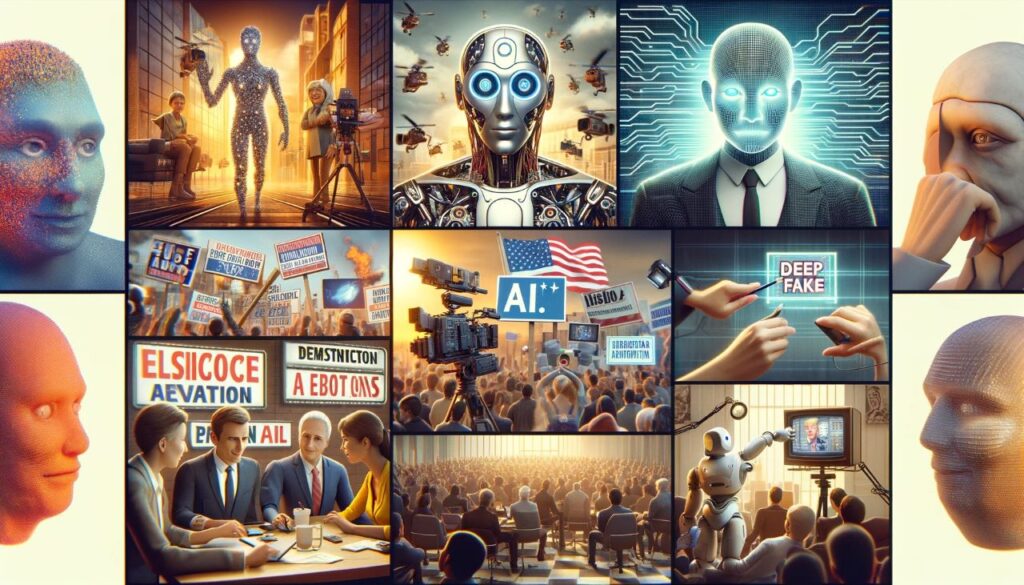As we usher in 2024, the AI in Filmmaking and Political Disinformation continues to evolve at a breakneck pace, redefining industries and societal norms. This article delves into the most significant AI developments, highlighting the transformative power of these technologies and their far-reaching implications.
Generative AI: Revolutionizing the Film Industry
The advent of generative AI in the film industry marks a groundbreaking shift. Runway, a pioneering startup in generative video models, has unveiled tools that produce videos of astonishing quality, reminiscent of Pixar’s work. This innovation is rapidly gaining traction among major studios like Paramount and Disney, integrating AI into their production pipelines for tasks like lip-syncing and special effects enhancement. A notable example is the AI-driven de-aging of Harrison Ford in “Indiana Jones and the Dial of Destiny.”
Moreover, the UK-based Synthesia is pushing the boundaries further, enabling the creation of deepfake avatars from a single actor’s performance. Such advancements, while impressive, raise ethical concerns regarding actors’ rights and the potential misuse of AI in filmmaking.

The Menace of AI-Generated Election Disinformation
The political realm is not immune to AI’s influence. AI-generated disinformation is becoming a formidable tool in elections, as evidenced in countries like Argentina and Slovakia. Deepfakes and AI-created memes, once a domain of technical experts, are now easily accessible, escalating the challenge of discerning truth in the digital age. This trend poses a significant threat to political integrity and public trust.
Multitasking Robots: A Leap Forward
In robotics, the integration of generative AI techniques has led to the development of more versatile robots capable of performing a wide range of tasks. This shift from specialized to general-purpose robots reflects the broader trend in AI towards more adaptable and comprehensive models. These advancements promise to expand the role of robotics in various sectors, from domestic to industrial applications.
Customized Generative AI Models: Niche Market Solutions
In the business sector, the focus is shifting towards customized generative AI models. These tailored solutions are particularly beneficial for industries with specialized needs, such as healthcare, finance, and legal. The move towards domain-specific models is also driven by privacy and security considerations, with organizations increasingly opting for proprietary models to safeguard sensitive data. This trend underscores the growing importance of AI customization in addressing specific business challenges and regulatory requirements.
The Growing Demand for AI Talent
The surge in AI adoption has sparked a significant demand for skilled professionals in AI and machine learning. The gap between theoretical knowledge and practical application is a critical area, highlighting the need for expertise in deploying, monitoring, and maintaining AI systems in real-world settings. As AI continues to permeate business operations, the hunt for talent with these specialized skills intensifies, cutting across various industries.
Shadow AI: A Double-Edged Sword
The phenomenon of “Shadow AI,” where AI is used within organizations without formal approval, is on the rise. This trend reflects the growing accessibility of AI tools and the eagerness of employees to explore new technologies. While this can drive innovation, it also introduces risks related to security, data privacy, and compliance, particularly when sensitive information is involved.
Conclusion
As we navigate through 2024, the advancements in AI are reshaping our world in unprecedented ways. From revolutionizing filmmaking to influencing political landscapes, and from fostering business innovation to creating new challenges in workforce development, AI’s impact is profound and multifaceted. As we embrace these changes, it is crucial to balance the benefits of AI with the ethical, societal, and security considerations it entails. The journey of AI is far from over, and its future developments will undoubtedly continue to surprise and challenge us.
In conclusion, AI technology stands at a pivotal juncture, with its potential for innovation matched only by the complexities it introduces. It is an exciting, yet daunting era, where the boundaries of technology continue to expand, promising both unparalleled opportunities and new challenges to overcome.